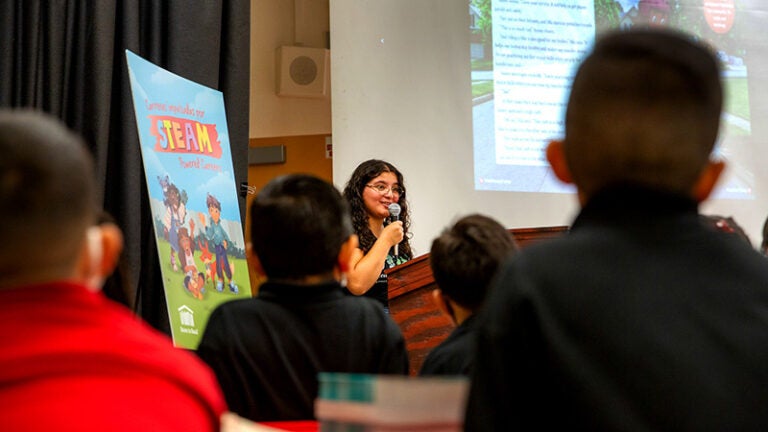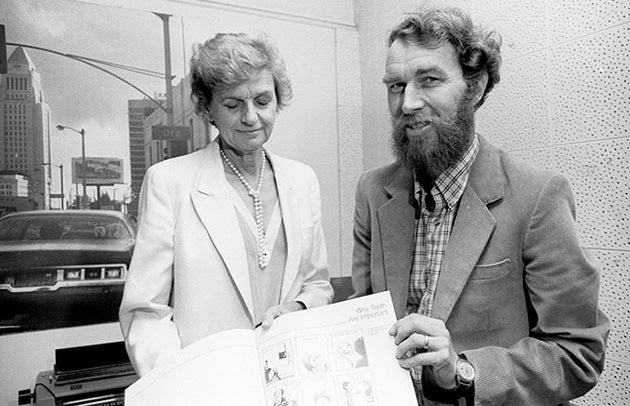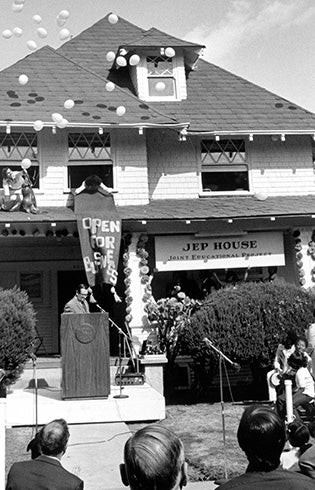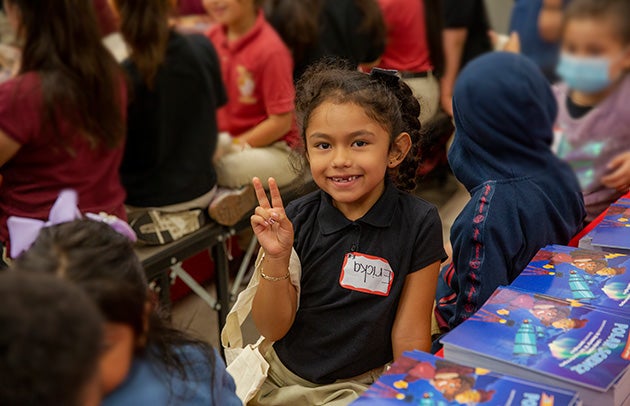
A beautiful day in the neighborhood: Joint Educational Project celebrates 50 years of service to the community
Highlights:
JEP matches USC students with elementary school classrooms as well as hospitals and nonprofits to provide volunteer hours.
These innovative programs were a main reason the university was named “College of the Year” by Time magazine in 2000.
JEP announces the Tammara Seabrook Anderson Spirit of Service Award Fund, created to help more students participate in the program.
Jasmin Sanchez may not have chosen a science major in college if not for the work of the Joint Education Project (JEP) at the USC Dornsife College of Letters, Arts and Sciences.
In elementary school, most of her science lessons came from books or lectures, with little hands-on learning. Her teacher grappling with a class size of nearly 30 students, didn’t have the time or resources to conduct hands-on demonstrations and answer every student’s in-depth STEM questions. For a visual learner like Sanchez, staying interested under these circumstances proved challenging.
JEP pairs USC students with local schools to enhance lessons, and when they showed up in Sanchez’s classroom one day, it changed everything.
“They provided all the materials for the students to have hands-on experiments. We got to use our hands and feel it, really figure out what we’re doing,” she says. “One of the reasons I got into science was because I had these students coming in and teaching me, bit by bit.”
Sanchez graduated from USC Dornsife last spring with a degree in health and human sciences and plans to become an occupational therapist. During her time at USC, she’s also come full-circle, teaching science to third graders through JEP, just as she was instructed a decade earlier.
This was the exact sort of outcome that the early organizers of JEP, which is celebrating its 50th anniversary this year, hoped for when the organization began in 1972.
A million hours of community connections

In the early 1970s, tension marred USC’s relationship with its surrounding neighbors. Barbara Seaver Gardner, a research associate at USC’s Center for Urban Affairs, had the vision to make a change by bringing USC and its surrounding neighbors together around a common goal: helping children.
She brought together principals of local elementary schools and USC faculty members to propose her idea: placing university students in the schools as mentors or teaching assistants, where they could assist in providing children with a quality education while learning about the community they would call home for the next four years.
She arranged for USC students to teach in elementary school classrooms near campus, providing valuable support to schools that were often underfunded and short-staffed, in effect founding JEP as its inaugural director.
Richard Cone succeeded Gardner, serving as JEP director from 1980 to 2002 and founding the USC ReadersPlus program, which provides reading and writing tutors for kids. Cone believed that the organization’s strength lay in making use of our human potential.
“One of the resources our society has not tapped very well is the human resource,” said Cone, who died in 2020. “Not since the Roosevelt days have we thought about how to use human resources instead of trying to buy our way out of problems.”
During his tenure at JEP, Time magazine and the Princeton Review featured USC as “College of the Year,” citing JEP’s service-learning as one of its primary reasons for the honor.

“In the early days, folks on campus saw JEP almost as a charity arm of the university . … They didn’t think about the program as mutually beneficial, with our students and our neighbors learning with and from each other,” says Tammy Anderson, associate dean for experiential learning and former JEP executive director. “Not only did we help to make USC a better university, we became an international model of service-learning as representatives from other higher ed institutions around the world came to learn from and observe our programs.”
JEP honored Anderson, who was involved with the program for nearly 40 years, by announcing an award fund in her name at their 50th anniversary gala on Nov. 3. Designed to help more students participate with JEP, the Tammara Seabrook Anderson Spirit of Service Award Fund provides stipends for low-income students who can’t afford to contribute unpaid service hours.
Around 2,000 USC students now participate in JEP programs each year. While they gain valuable experience in the classroom, younger students like Sanchez benefit from hands-on learning time, and teachers get a little help with their workload.
Since its founding, some 100,000 JEP students have provided over a million hours of service to schools.
JEP offers more than just classic educational support focused on math, literacy or STEM subjects. The Peace Project trains USC students in a peace education curriculum that they then bring into classrooms. Little Yoginis provides elementary school children with yoga instruction.
Students also go beyond the classroom in their mission to connect with the surrounding community. The Understanding Homelessness Through Service program pairs students with organizations like Chrysalis, which prepares people to reenter the workforce.
USC students can also work with Trojan Health Volunteers, which places them in local clinics and hospitals to gain experience in health care settings. The program was founded by student Daniel Porter, who went on to become a physician after graduating from USC Dornsife in 1987.
Students serving students — it works both ways
Alumni of JEP are as impacted by the program as the young students they teach.
Tom Chan ’96 originally majored in business, but participating in JEP ignited a new enthusiasm for social service and teaching. He switched to a liberal arts major, served in the Peace Corps in Thailand, then received a master’s degree in educational administration.
He is now director of special projects and student services in the Fillmore Unified School District in Fillmore, California, where his office assists students with disabilities.
“If I had never served in JEP, I don’t think I would have been brave enough to change my major to liberal arts as a junior,” says Chan. “I never would have become a professional journalist, certainly never would have joined the Peace Corps, and never would have chosen education as a career path.”
He also would not have met his wife. The two bumped into each other while hanging out at the JEP House on campus.
New books help kids build up a head full of STEAM
Fifty years of success doesn’t mean the JEP crew is content to rest on their laurels. On Oct. 6, in partnership with the global educational organization Room to Read, they released a series of 10 children’s books themed around science, technology, engineering, arts and math — or “STEAM” — subjects.

The brainchild of Dieuwertje “DJ” Kast, JEP’s director of STEM education programs, the books are designed for elementary school-age children and cover a range of topics, from marine biology to virtual reality, and showcase diverse scientists and their work.
Scientist Stacey Finley, Gordon S. Marshall Early Career Chair and associate professor of biomedical engineering, chemical engineering and materials science, and biological sciences at the USC Viterbi School of Engineering, helped write the volume on data science.
“I wrote the book with my own children in mind. They need to see more books featuring people of color, to inspire them and broaden their perspective,” Finley wrote on Twitter.
Some 9,000 sets of the books will be distributed to children and schools through USC neighbor educational programs such as the Viterbi K-12 STEM Center and the USC Leslie and William McMorrow Neighborhood Academic Initiative. Educational videos and lesson plans for teachers are also available.
An expanding legacy
It’s a continuation of JEP’s five decades of work within the community that surrounds campus, helping to uplift the children who will be the scientists, artists, educators and leaders of tomorrow.
“I’m just so incredibly proud of what we’ve been able to accomplish in these 50 years,” says Susan Harris, JEP’s executive director. “So many students have come through JEP’s doors and been able to make a meaningful change in communities and then go on to do amazing things in their own lives.”